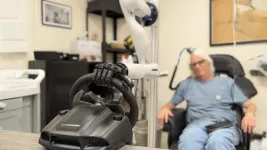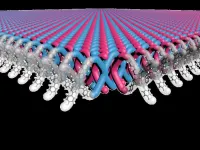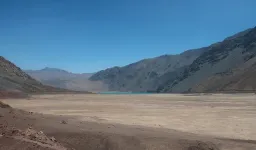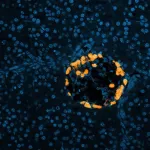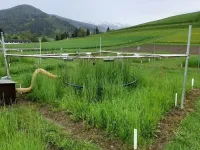(Press-News.org) A novel field experiment in Austria reveals that compounding climate conditions – namely drought, warming, and elevated atmospheric carbon dioxide (CO2 ) – could fundamentally reshape how water moves through soils in temperate grasslands. The findings provide new insights into post-drought soil water flow, in particular. Soil water, though a minuscule fraction of Earth's total water resources, plays a critical role in sustaining terrestrial life on Earth by regulating biogeochemical cycles, surface energy balance, and plant productivity. Soils also govern the fate of precipitation, directing it back to the atmosphere via evapotranspiration or into surface and groundwater systems, depending on soil water storage and flow properties, such as soil texture and structure. However, droughts – expected to become more frequent and severe under change – could disrupt these crucial processes. Atmospheric warming may increase evapotranspiration and soil water loss, while elevated atmospheric CO2 could reduce transpiration by narrowing plant stomata and conserving soil moisture. Thus, the combined effects of warming and elevated CO2 can produce complex, albeit poorly understood, hydrological outcomes. Grasslands, which cover 30-40% of Earth's land surface, depend heavily on shallow soil water, making them ideal for studying rootzone ecohydrological dynamics.
Jesse Radolinski et al. conducted a novel deuterium (²H) labeling field experiment in a temperate grassland in Austria to examine how elevated atmospheric CO2, warming, and recurring drought – individually and in combination – affect soil water. Radolinski et al. induced experimental drought conditions and then applied 2H-labeled rainfall under ambient and simulated future climate scenarios. According to the findings, elevated CO2 increased rootzone moisture, while warming reduced soil moisture, with soil water remaining well mixed under most conditions. However, combined summer drought, warming, and elevated CO2 drove grassland plants to conserve water by reducing transpiration, which restricted soil water flow to large, rapidly draining pores, limiting mixing with smaller pores. The findings suggest that future drought conditions could fundamentally alter soil water dynamics by limiting post-drought soil water flow and grassland vegetation water use.
END
Compounding drought and climate effects disrupt soil water dynamics in grasslands
Summary author: Walter Beckwith
2025-01-16
ELSE PRESS RELEASES FROM THIS DATE:
Multiyear “megadroughts” becoming longer and more severe under climate change
2025-01-16
Severe droughts are becoming hotter, longer, and increasingly devastating to ecosystems as climate change accelerates, according to a new study, which reports that temperate grasslands, including in parts of the United States, are facing the worst effects. The findings provide a global quantitative understanding of multiyear droughts (MYDs) – prolonged events lasting years or decades – and offer a benchmark for understanding their global trends and impacts. As droughts become more frequent ...
Australopithecines at South African cave site were not eating substantial amounts of meat
2025-01-16
Seven Australopithecus specimens uncovered at the Sterkfontein fossil site in South Africa were herbivorous hominins who did not eat substantial amounts of meat, according to a new study by Tina Lüdecke and colleagues. Lüdecke et al. analyzed organic nitrogen and carbonate carbon isotopes extracted from tooth enamel in the fossil specimens to determine the hominin diets. Some researchers have hypothesized that the incorporation of animal-based foods in early hominin diets led to increased brain size, smaller gut size ...
An AI model developed to design proteins simulates 500 million years of protein evolution in developing new fluorescent protein
2025-01-16
Guided by a multimodal generative language model called ESM3, Thomas Hayes and colleagues generated and synthesized a previously unknown bright fluorescent protein, with a genetic sequence so different from known fluorescent proteins that the researchers say its creation is equivalent to ESM3 simulating 500 million years of biological evolution. The model could provide a new way to “search” the space of protein possibilities with an eye to better understanding how naturally evolved proteins work, as well as developing novel proteins for uses in medicine, environmental remediation, and a host of other applications. ESM3 can reason over protein ...
Fine-tuned brain-computer interface makes prosthetic limbs feel more real
2025-01-16
You can probably complete an amazing number of tasks with your hands without looking at them. But if you put on gloves that muffle your sense of touch, many of those simple tasks become frustrating. Take away proprioception — your ability to sense your body’s relative position and movement — and you might even end up breaking an object or injuring yourself.
“Most people don’t realize how often they rely on touch instead of vision — typing, walking, picking up a flimsy cup of water,” said Charles Greenspon, PhD, a neuroscientist at the University of Chicago. “If you can’t feel, you have ...
New chainmail-like material could be the future of armor
2025-01-16
EVANSTON, Il. --- In a remarkable feat of chemistry, a Northwestern University-led research team has developed the first two-dimensional (2D) mechanically interlocked material.
Resembling the interlocking links in chainmail, the nanoscale material exhibits exceptional flexibility and strength. With further work, it holds promise for use in high-performance, light-weight body armor and other uses that demand lightweight, flexible and tough materials.
Publishing on Friday (Jan. 17) in the journal ...
The megadroughts are upon us
2025-01-16
Increasingly common since 1980, persistent multi-year droughts will continue to advance with the warming climate, warns a study from the Swiss Federal Institute for Forest, Snow, and Landscape Research (WSL), with Professor Francesca Pellicciotti from the Institute of Science and Technology Austria (ISTA) participating. This publicly available forty-year global quantitative inventory, now published in Science, seeks to inform policy regarding the environmental impact of human-induced climate change. It also detected previously ‘overlooked’ events.
Fifteen years of a persistent, devastating megadrought—the longest lasting in a thousand years—have nearly dried out ...
Eavesdropping on organs: Immune system controls blood sugar levels
2025-01-16
When we think about the immune system, we usually associate it with fighting infections. However, a study published in Science by the Champalimaud Foundation reveals a surprising new role. During periods of low energy—such as intermittent fasting or exercise—immune cells step in to regulate blood sugar levels, acting as the “postman” in a previously unknown three-way conversation between the nervous, immune and hormonal systems. These findings open up new approaches for managing conditions like diabetes, obesity, and cancer.
Rethinking the Immune ...
Quantum engineers ‘squeeze’ laser frequency combs to make more sensitive gas sensors
2025-01-16
The trick to creating a better quantum sensor? Just give it a little squeeze.
For the first time ever, scientists have used a technique called “quantum squeezing” to improve the gas sensing performance of devices known as optical frequency comb lasers. These ultra-precise sensors are like fingerprint scanners for molecules of gas. Scientists have used them to spot methane leaks in the air above oil and gas operations and signs of COVID-19 infections in breath samples from humans.
Now, in a series of lab experiments, researchers have laid out a path for making those kinds of measurements even more sensitive and faster—doubling the speed of ...
New study reveals how climate change may alter hydrology of grassland ecosystems
2025-01-16
New research co-led by the University of Maryland reveals that drought and increased temperatures in a CO2-rich climate can dramatically alter how grasslands use and move water. The study provides the first experimental demonstration of the potential impacts of climate change on water movement through grassland ecosystems, which make up nearly 40% of Earth’s land area and play a critical role in Earth’s water cycle. The study appears in the January 17, 2025, issue of the journal Science.
“If we want to predict the effects of climate change ...
Polymer research shows potential replacement for common superglues with a reusable and biodegradable alternative
2025-01-16
EMBARGO: THIST CONTENT IS UNDER EMBARGO UNTIL 2 PM U.S. EASTERN STANDARD TIME ON JANUARY 16, 2025. INTERESTED MEDIA MAY RECIVE A PREVIEW COPY OF THE JOURNAL ARTICLE IN ADVANCE OF THAT DATE OR CONDUCT INTERVIEWS, BUT THE INFORMATION MAY NOT BE PUBLISHED, BROADCAST, OR POSTED ONLINE UNTIL AFTER THE RELEASE WINDOW.
Researchers at Colorado State University and their partners have developed an adhesive polymer that is stronger than current commercially available options while also being biodegradable ...
LAST 30 PRESS RELEASES:
Numbers in our sights affect how we perceive space
SIMJ announces global collaborative book project in commemoration of its 75th anniversary
Air pollution exposure and birth weight
Obstructive sleep apnea risk and mental health conditions among older adults
How talking slows eye movements behind the wheel
The Ceramic Society of Japan’s Oxoate Ceramics Research Association launches new international book project
Heart-brain connection: international study reveals the role of the vagus nerve in keeping the heart young
Researchers identify Rb1 as a predictive biomarker for a new therapeutic strategy in some breast cancers
Survey reveals ethical gaps slowing AI adoption in pediatric surgery
Stimulant ADHD medications work differently than thought
AI overestimates how smart people are, according to HSE economists
HSE researchers create genome-wide map of quadruplexes
Scientists boost cell "powerhouses" to burn more calories
Automatic label checking: The missing step in making reliable medical AI
Low daily alcohol intake linked to 50% heightened mouth cancer risk in India
American Meteorological Society announces Rick Spinrad as 2026 President-Elect
Biomass-based carbon capture spotlighted in newly released global climate webinar recording
Illuminating invisible nano pollutants: advanced bioimaging tracks the full journey of emerging nanoscale contaminants in living systems
How does age affect recovery from spinal cord injury?
Novel AI tool offers prognosis for patients with head and neck cancer
Fathers’ microplastic exposure tied to their children’s metabolic problems
Research validates laboratory model for studying high-grade serous ovarian cancer
SIR 2026 delivers transformative breakthroughs in minimally invasive medicine to improve patient care
Stem Cell Reports most downloaded papers of 2025 highlight the breadth and impact of stem cell research
Oxford-led study estimates NHS spends around 3% of its primary and secondary care budget on the health impacts of heat and cold in England
A researcher’s long quest leads to a smart composite breakthrough
Urban wild bees act as “microbial sensors” of city health.
New study finds where you live affects recovery after a hip fracture
Forecasting the impact of fully automated vehicle adoption on US road traffic injuries
Alcohol-related hospitalizations from 2016 to 2022
[Press-News.org] Compounding drought and climate effects disrupt soil water dynamics in grasslandsSummary author: Walter Beckwith
